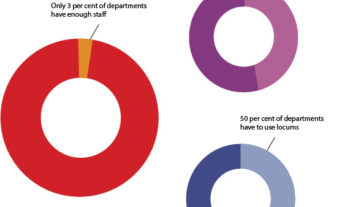In this issue, experts summarise the development of genetics and genomics per se, and their application and role in pathology and precision medicine. The roll-out of genomics within national programmes, such as the 100,000 Genomes Project, has provided the tissue pathways and infrastructure needed for the NHS to provide equitable access to genomic testing within its new genomic medicine service (GMS). The development of the GMS brings with it additional demands that must be met by existing understaffed pathology laboratories and pathology curricula essentially in real time, to rapidly upskill and finance this fast-changing development. The subsequent integration of relevant genomic data into multidisciplinary team meetings and, ultimately, clinical care will enable more personalised treatment and patient management. Furthermore, the research, development and innovation opportunities that already exist and will continue to evolve as the data is mined will further improve diagnostics and therapies.
As exciting as this genomics era is, and how bright the future does indeed appear to be, I think it is important that we step back and remember how we actually got here, by acknowledging some of the ground-breaking discoveries that were made by scientists and clinical academics over the years (see Box 1). These landmark discoveries and innovations dramatically changed work flows in pathology departments, medical practice and our lives. As the COVID-19 pandemic has highlighted to all of us, the development of targeted rapid diagnostics and ultimately vaccines, involves ‘blood, sweat and tears’ of dedicated experienced teams undertaking numerous experiments and clinical trials, involving patients and volunteers.
It is clear from the timeline that we have experienced and are still going through a ‘genomic revolution’, which is occurring at a rapid pace − one that we are adjusting to but must catch up with, in terms of pathologists’ roles in the genomic care pathway, education of the pathology workforce, its application in clinical care and its wider implications in society (e.g. consent). Promisingly, in time, more human diseases will be understood at the molecular level, leading to the development of novel drugs, individualising treatments and hopefully improving outcomes.
| 1953 | Discovery of the double helix structure of DNA by Watson, Crick and Franklin |
| 1955 | The exact number of chromosomes in human cells being defined as 46 by Hin Tjio |
| 1959 | Lejeune and his colleagues discovering that Down syndrome is caused by trisomy 21 |
| 1973 | The demonstration of recurrent translocations in acute myeloid leukaemia [AML, t(8;21)] and chronic myeloid leukaemia [CML, t(9;22)] by Rowley |
| 1975 | Two groups, Sanger and colleagues, and Maxam and Gilbert, both developing rapid DNA sequencing methods |
| 1982 | Formation of a public GenBank Database at the National Institutes of Health (NIH) for complicated DNA sequences |
| 1983 | The invention of PCR to amplify DNA by Mullis and Smith |
| 1984 | Discovery of repetitive DNA sequences called microsatellites (MSI) as genetic landmarks to distinguish between people by Weller, Jeffreys and colleagues |
| 1990 | Launch of the Human Genome Project (with completion of its first draft in spring 2000, at a cost of $3.5 billion, with an estimated accuracy of 99.9%) |
| 1997−1998 | The complete sequencing of various organisms, e.g. Escherichia coli, Mycobacterium tuberculosis and Caenorhabditis elegans |
| 2002−2005 | Mouse and rat genomes drafted by respective Genome consortia Commencement of ‘The Cancer Genome Atlas’ (TCGA) project, examining 33 differing cancer types at the DNA, RNA and protein levels |
| 2007−2008 | Application of next generation sequencing (also called ‘massively parallel sequencing’) to |
| 2013 |
Development of single cell sequencing by Lasken Two teams independently led by Charpentier and Doudna developed ‘Clustered Regularly Interspaced Short Palindromic Repeats’ (CRISPR)-Cas9 gene editing technologies |
| 2016 | Launch of the 100,000 Genomes Project by Genomics England with the establishment of Genomic Medical Centres |
| 2018 | Inception of the UK Biobank Resource, a prospective cohort study with deep genetic and phenotypic data collected on approximately 500,000 individuals |
| 2020 |
Establishment of the Genomic Laboratory Hubs in NHS England Extraordinary and rapid development of effective vaccines against SARS-CoV-2 through global collaborative efforts of vaccine researchers, companies, philanthropists and volunteers |
| 2021 | Goals to combine molecular, digital and bioinformatics technologies in routine healthcare |




